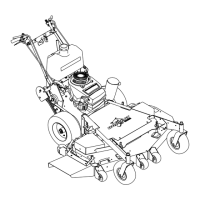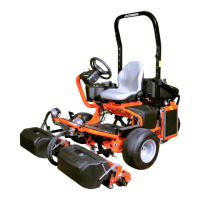Do you have a question about the Textron Bob-Cat and is the answer not in the manual?
Immediate hazards which will result in severe personal injury or death.
Hazards or unsafe practices which could result in severe personal injury or death.
Hazards or unsafe practices which could result in minor personal injury or product or property damage.
Information for Ransomes Bob-Cat product owners, emphasizing product utility and service.
Warning about unauthorized modifications and their potential hazards and warranty voiding.
Warning about rotating blades, urging caution and safety measures.
Warnings regarding thrown objects and safety precautions for operation.
Crucial instructions for safe operation, including fuel valve and flooding precautions.
Warnings for starting, servicing, and leaving the operator position safely.
Visual guide to controls including speed, blades, and starting positions for specific models.
Comprehensive safety advice for operation, including debris, interlocks, and unauthorized users.
Instructions for checking and filling hydraulic oil levels with specific oil type.
Guidelines for operator training, emphasizing manual study and safety precautions.
Steps for preparing the machine before use, including safety checks and fuel handling.
Instructions on safe operating practices, including confined spaces, lighting, and footing.
Detailed advice for safe operation on slopes, including caution and direction of mowing.
Procedure for safely leaving the operator's position, including engine stop and brake application.
General guidance on maintenance, adjustments, and safety during these tasks.
Recommendations for safely storing the equipment, especially concerning fuel and fire hazards.
Steps for uncrating and placing power unit and cutter deck on pallets.
Instructions for installing the fuel tank with bolts, washers, and connecting the fuel line.
Guidance on assembling the upper and lower handle sections using bolts and nuts.
Steps for connecting the wire harness to the engine kill wire and ground bolt for different engine types.
Instructions for connecting throttle and choke cables for various engine models and adjustments.
Routing advice for Vanguard throttle cables to prevent pinching or binding.
Instructions for connecting throttle (T) and choke (K) cables on Kohler V-twin engines.
Connecting the blade control rod to the bell crank and adjusting its lever for the 'off' position.
Instructions for attaching speed control and traction levers, referring to the adjustment section.
Special instruction for 61" cutterdeck hookup, including engine pulley replacement and torque.
Steps for bolting the cutter deck and power unit together and removing supports.
Installing casters with bolts and nuts, and adjusting tire pressure to 14 psi.
Emphasizing the necessity of fitting a grass catcher or discharge chute for machine use.
List of items to adjust, including belts, over-center, guides, and blade brake.
Key setup steps before operation: reading manual, running engine, throttle use, and belt readjustment.
Description of operator presence controls and their function in engine kill and starting.
Instructions for using the blade control lever, including engagement, disengagement, and safety.
How to use the throttle and choke controls for engine speed and starting, including single cylinder variations.
Explanation of speed selector levers for setting forward/reverse speeds and tracking adjustments.
Instructions for starting and stopping the engine using the keyswitch for different models.
Detailed guide on using traction levers for movement, steering, and neutral positions with locks.
How to operate the choke control on V-twin and recoil start models with Vanguard engines.
Safe practices for fueling, including location, smoking, and fill level.
Step-by-step instructions for starting the engine, including oil check, fuel valve, choke, and starter operation.
Guidance on practicing controls, using throttle and speed selectors for efficient cutting.
Steps for mowing, including chute/collector, operator controls, blade engagement, and speed.
Safety measures to prevent injury from thrown objects and blade contact.
Procedure for safely stopping the machine, including traction levers, blade disengagement, and engine shutoff.
Instructions for initial engine oil change and daily oil level checks.
Points to lubricate with grease every 50 working hours, including pivots and tensioners.
Steps for checking, draining, and filling the hydraulic reservoir and changing oil/filter.
How to inspect spark plugs for condition and proper gap setting.
Daily check of the operator presence system for proper function and safety shutoff.
Guidance on replacing missing or illegible decals and labels for safety.
Daily checks for engine oil leaks and cleaning the air intake screen.
Instructions for cleaning the air cleaner precleaner and replacing the paper element.
Guidance on replacing the in-line fuel filter when necessary.
Maintaining correct tire pressure at 14 psi for optimal performance.
Procedures for sharpening blades, maintaining balance, and using Ransomes blades.
Step-by-step instructions for safely removing cutter deck blades using tools.
Steps for reinstalling blades, including spacers, washers, and proper torque specification.
How to adjust cutting height by repositioning spacers on caster wheel pivot spindles.
Instructions for using blade spacers to set cutting height, including removal and reinstallation steps.
Adjusting the cutter deck position relative to the engine deck for cutting height.
Steps to change wheel motor positions for high or low cutting positions, including plate rotation.
Procedure for setting and adjusting the neutral position for traction drive.
Steps for adjusting speed control rods to ensure proper tracking and neutral settings.
Adjusting traction levers for neutral, steering, and reverse, including play requirements.
Adjusting friction on speed control levers to ensure they hold position and move together.
Adjusting the parking brake rod for proper engagement and machine immobilization.
Adjusting the blade control rod for correct engagement and the 'off' position snap.
Adjusting operator present controls to ensure proper switch operation for safety.
Instructions for adjusting the handlebar height by removing and loosening bolts.
Note that the hydro drive belt tension is spring-loaded and typically requires no adjustment.
How to adjust engine to deck belt tension using a turnbuckle and checking deflection.
Checking and resetting over-center adjustment for the engine to deck belt for proper engagement.
Adjusting the spindle blade brake for proper stopping distance and ensuring it does not bind.
Adjusting cutter deck belt tension using the idler pulley adjustment rod and locknut.
Adjusting engine belt guides to maintain proper spacing from the engine to deck belt.
Adjusting the idler belt guide fitted to the V-idler pulley for correct belt alignment.
Steps for removing and replacing the cutter deck belt, including tensioning.
Procedure for replacing the engine-to-deck belt, including guide adjustments.
Steps for removing and replacing the hydro drive belt, including tension release.
Steps to convert a Versadeck mulching deck to a side discharge deck, including baffle and blade changes.
Details on controls, speed, tires, brakes, transmission, hydraulics, and weight for power units.
Specifications for deck construction, drive system, spindles, casters, rollers, height, and blade brake.
List of optional accessories available for the machine, such as sulkies and catchers.
Torque specifications for various American National Standard fasteners by size and grade.
Specific torque values for blade bolts, wheel hub nuts, and engine crankshaft bolt.
Details the one-year warranty, limitations, and required proof of purchase for Ransomes products.
Lists items not covered by warranty, including normal wear, misuse, and unauthorized modifications.
Steps for making a warranty claim, including contacting a dealer and delivering the unit.
Examples of services and parts excluded from warranty coverage, such as normal wear and tear.
Owner's responsibility for proper maintenance, lubrication, fuel, battery, and tire pressure to validate warranty.
Statement on product quality, performance, and support backed by ISO 9001 registration.
Information about the worldwide dealer network and factory-trained technicians for product support.
| Category | Lawn Mower |
|---|---|
| Manufacturer | Textron |
| Brand | Bob-Cat |
| Engine Type | Gasoline |
| Engine Power | Varies by model |
| Cutting Width | Varies by model |
| Fuel Tank Capacity | Varies by model |
| Weight | Varies by model |
| Transmission | Varies by model |












